Recent Posts
Bathroom Sink Leak Troubles? Signs, Causes & Top Tips for Prevention
2/18/2025 (Permalink)
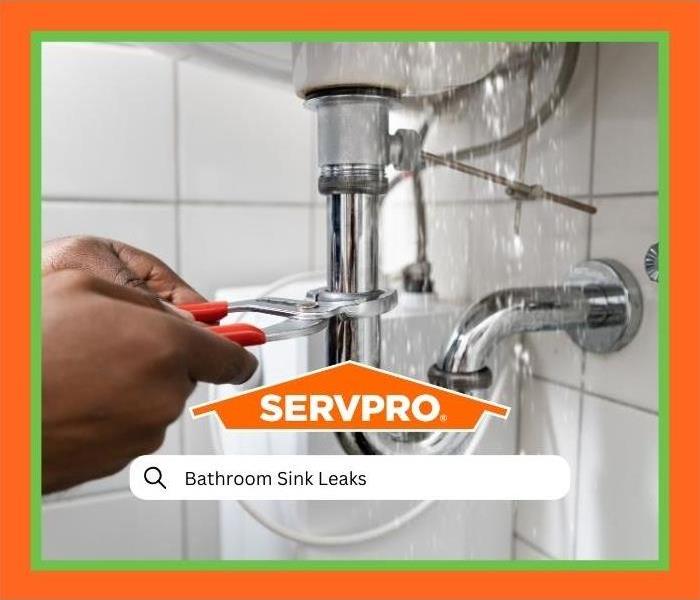 Bathroom Sink Leaks
Bathroom Sink Leaks
Your bathroom sink is one of the most frequently used fixtures in your home. But did you know it can also be a major source of water damage? A small bathroom sink leak or a clogged drain might not seem like a big deal at first, but over time, these issues can lead to structural damage, mold growth, and finally, Weymouth MA water damage restoration. For homeowners to protect their property from serious water damage, it is necessary to first understand common bathroom sink issues, early warning signs, and preventive maintenance tips.
Common Bathroom Sink Problems: What’s Causing Leaks?
Bathroom sinks may seem sturdy. However, minor plumbing issues have the potential to mess up your bathroom in no time. Here are the most common causes of water damage related to bathroom sinks:
Leaky Faucets
A dripping faucet might not seem urgent at first, but even a slow leak can gradually waste a lot of water and cause moisture buildup. Over time, this can lead to mold growth, corrosion, and higher water bills.
Broken or Worn-Out Seals
Bathroom sinks have rubber seals and gaskets that prevent water from leaking around the faucet and drain. If these seals wear out or break, water can easily seep into cabinets, walls, or floors, causing hidden water damage.
Blockages in Drains
When soap scum, hair, and debris accumulate, this buildup usually creates a blockage, leading to standing water as it can’t drain properly. When water sits in the sink for too long, it can cause water to overflow, damaging the surrounding countertops and cabinets.
Loose or Cracked Pipes
Pipes under the sink can loosen over time due to daily use, temperature changes, or old plumbing materials. A slow pipe leak can cause water stains, rot, and mold growth under your bathroom sink.
Overflowing Sink
Forgetting to turn off the faucet or experiencing a severely clogged drain can cause a bathroom sink to overflow. The excess water can seep into floors, walls, and even nearby rooms, creating more damage and expensive repairs.
How Do I Know if My Bathroom Sink Is Leaking?
Tackling water damage under the sink has to be done quickly to avoid even more damage to surrounding materials. But, how can you tell if your bathroom sink is causing water damage? Look out for these warning signs:
- Standing Water: If water pools around the base of the sink or under the cabinet, there may be a leak somewhere in the background.
- Slow Drainage: If water takes too long to drain, there could be a clog forming in the pipes.
- Water Stains Under the Sink: Brown or yellow stains under the sink are a sign of a hidden water leak.
- Musty Smell: Dampness under the sink can lead to mold growth, which produces a musty odor.
- Peeling Paint or Swollen Cabinets: If moisture is present under the sink, it can cause wood to warp or paint to bubble and peel.
Maintenance Tips for Preventing Bathroom Sink Water Damage
Regular maintenance is the best way to keep your bathroom sink in good condition and prevent plumbing-related water damage. Here are some simple but effective tips:
- Don’t Delay Fixing Leaks: Even a small leak can cause major damage over time. If you notice a dripping faucet, leaking pipe, or water pooling under the sink, repair it as soon as possible.
- Keep Drains Clear: Use a drain guard to catch hair and debris, and flush the drain with hot water and baking soda every month to prevent buildup. You should also avoid pouring grease, soap scum, or heavy chemical cleaners down the drain, as they can cause blockages.
- Keep Seals and Pipes in Check: Inspect the sink’s seals, gaskets, and pipes every few months for potential damage. If you see cracks, gaps, or loose connections, replace them before they cause leaks.
- Don’t Overload the Sink Cabinet: Too much weight under the sink can shift pipes and weaken seals, increasing the risk of leaks. Store only lightweight essentials under your sink.
- Watch for Early Signs of Damage: Regularly check for water stains, dampness, or mold growth under the sink and on nearby walls or floors. This small step can play a big part in reducing the cost of water damage restoration.
How SERVPRO of Weymouth, Hingham, and Quincy Can Help
If your bathroom has already experienced sink water damage, take action now! SERVPRO of Weymouth, Hingham, and Quincy provides professional water damage restoration services in Boston, MA, Weymouth, Hingham, Weymouth Landing, and surrounding areas. Our expert technicians use advanced drying equipment and proven restoration techniques to restore your home after water disasters.
Our Services Include:
- Leak Detection & Repair: Identifying and fixing hidden leaks before they cause further damage.
- Water Damage Restoration: Drying, cleaning, and restoring water-damaged areas.
- Mold Remediation: Addressing mold growth caused by excess moisture.
- Structural Repairs: Fixing walls, and flooring.
Call Us for Expert Bathroom Sink Leak Damage Repair and Restoration!
Don’t wait until a small leak turns your home upside down. If you notice signs of a bathroom sink problem, call SERVPRO of Weymouth, Hingham, and Quincy at (781) 337-0344 or fill out this online form. Our team is ready to provide you with immediate service!
Malfunctioning Appliances and Water Damage: Prevention Tips Every Homeowner Needs
2/4/2025 (Permalink)
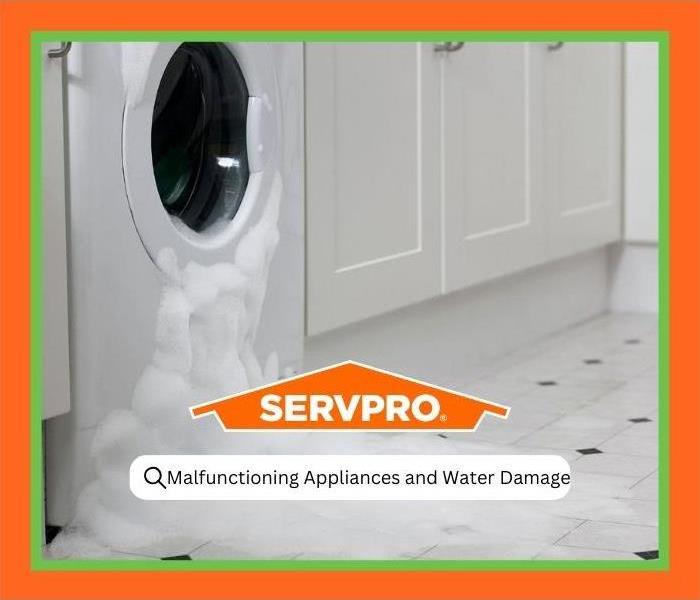 Malfunctioning Appliances and Water Damage
Malfunctioning Appliances and Water Damage
Water damage from malfunctioning appliances is an everyday concern for many Boston homeowners. Household appliances like washing machines, dishwashers, and refrigerators are designed to make our lives easier, but if there’s a glitch of any kind, many people face disastrous consequences that involve costly repairs. For Boston residents, it’s important to understand why appliances malfunction so that they can take steps to maintain them and know when to seek Weymouth MA water damage restoration services.
What Are Common Malfunctioning Appliances That Lead to Water Damage?
Several household appliances are prone to leaks and water damage when they are faulty or badly maintained. Let’s explore the most common causes of water damage from appliance issues:
- Washing Machine Leaks: Washing machines are among the leading causes of household water damage. Common problems include loose or damaged hoses, improper installation, or overloaded machines. A tiny drip can escalate into a major disaster if you ignore it long enough.
- Dishwasher Leaks: Dishwashers can leak due to worn-out door seals, clogged drains, or overloading. Even a minor leak can seep under your flooring, causing hidden damage beneath that can lead to mold growth.
- Broken Water Heaters: A failing water heater can flood your place in a short time. Tank corrosion, loose connections, or pressure build-up are threats that usually lead to catastrophic leaks.
- Refrigerator Waterline Leaks: Refrigerators with built-in water dispensers or ice makers rely on waterlines that can crack, clog, or disconnect. Because they happen behind the appliance, it’s likely that you will notice the problem when it’s already too late.
- Malfunctioning Fire Sprinklers: Fire sprinklers are there to warn you of emergencies, but when they malfunction, they can cause extensive water damage. Corrosion, accidental activation, or faulty components can all lead to leaks.
- Garbage Disposal Leaks: Garbage disposals are another common source of water damage in kitchens. They usually start leaking due to improper installment, age, or damage.
- Appliance Hoses and Connections: Essential parts of any appliance are its hoses and connections which can degrade over time, leading to leaks. Typical examples that tend to fail are washing machine hoses, dishwasher connections, and water heater fittings.
What Are the Signs of Malfunctioning Appliances?
Spotting the first signs of water damage from a faulty appliance can spare you costly repairs and headaches from water damage. Keep an eye out for these clues:
- Puddles of Water: If you notice water pooling around an appliance, it’s likely leaking.
- Unusual Noises: Loud banging, hissing, or grinding sounds can indicate issues within the appliance.
- Rust or Corrosion: Rust on hoses, connectors, or the appliance itself is the most common water damage red flag.
- Slower Performance: If an appliance isn’t working as it usually does, it might have leaks or clogs.
- Musty Smells: That funky odor around your appliance might be a clue to hidden water damage or lurking mold.
How Can I Prevent Water Damage from Household Appliances?
Preventing appliance-related water damage can be easily done by staying proactive with regular checks and upkeep. Try these tips to keep your appliances running smoothly:
- Inspect Hoses and Seals: Check if the hoses have any cracks, bulges, or corrosion, and replace worn-out parts immediately.
- Clean Filters and Drains: Appliances like dishwashers and washing machines have filters and drains that can clog as they’re used almost every day. Make sure you clean these parts regularly to prevent blockages.
- Follow Manufacturer Guidelines: Avoid putting too many dishes or clothes in your machines. Use the appliance according to the manufacturer’s instructions to prevent unnecessary overloading.
- Install a Water Alarm: Water alarms can let you know about leaks early and alert you before significant damage strikes.
- Upgrade Outdated Appliances: Swap out old appliances for modern models with better safety features and improved efficiency.
- Book Regular Checkups: Schedule professional inspections for your appliances to catch potential problems early and prevent costly repairs.
We Are Your Trusted Partner in Water Damage Restoration
Dealing with water damage from faulty appliances can be stressful, but SERVPRO of Weymouth, Hingham, and Quincy has you covered. Proudly serving Boston, MA, Weymouth, Hingham, Weymouth Landing, and the surrounding areas, we provide professional water damage restoration services to get your home back to normal.
Here’s what you can expect from our expert team:
- Comprehensive Inspections: Our team identifies the source of the water damage and examines the extent of the problem.
- Water Extraction and Drying: We use advanced equipment to remove standing water and dry affected areas.
- Appliance Repair and Replacement: Whether your dishwasher, washing machine, or water heater is the problem, our skilled technicians can repair and replace faulty appliances, helping you stay on top of good plumbing maintenance.
- Mold Prevention: We take all the steps needed to prevent mold growth caused by excess moisture, ensuring your home stays safe and healthy.
- Insurance Assistance: We work directly with your insurance company to make the claims process as smooth as possible.
Contact Us Today for Your Appliance-Related Water Damage Needs
Don’t let malfunctioning appliances cause water damage to your home. Contact SERVPRO of Weymouth, Hingham, and Quincy today at (781) 337-0344 for expert water damage restoration services, or fill out this online form for a free quote. Our professionals are ready to help you restore your home and comfort!
Frozen Pipes: Learn All About Dangerous Risks and Top Prevention Tips
1/21/2025 (Permalink)
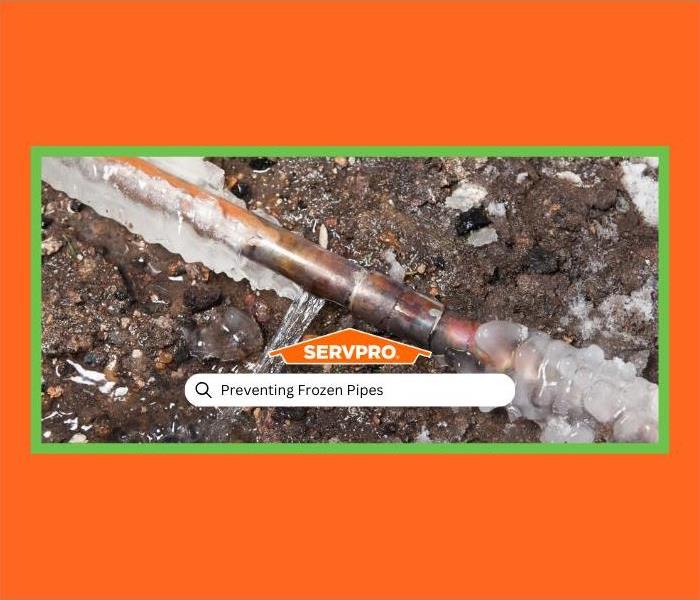 Frozen Pipes
Frozen Pipes
As winter temperatures plummet in Massachusetts, homeowners face a higher risk of frozen pipes, which are one of the common plumbing issues you can face. When water freezes, it creates pressure in the pipes to the point of bursting. This may look like a minor inconvenience, but it can quickly develop into a major water damage emergency, potentially making you dip into your savings for all the repairs needed. In these cases, turning to professionals for water damage restoration Weymouth services is your best option to prevent further damage.
Why Do Pipes Freeze?
Pipes can freeze overnight, causing a major headache for any homeowner. Here’s a breakdown of common causes of frozen pipes: https://www.SERVPROweymouthhingham.com/water-damage-tips
Poor Insulation
Poor insulation is your number one enemy in this case. Pipes in unheated areas like basements, crawl spaces, and attics are particularly vulnerable. Even pipes inside your walls can freeze and have hidden water damage if they lack proper insulation or if cold air finds its way through gaps in your home's exterior.
Sudden Temperature Drops
A sudden drop in temperature is another major cause of frozen pipes, especially in the Greater Boston area, where the weather can be unpredictable during winter. When temperatures suddenly fall below freezing, pipes don't have time to adjust to the temperature, increasing the likelihood of freezing.
Exposed Plumbing
Exposed pipes in unheated areas present another major risk. Keep in mind that garage pipes, outdoor spigots, and plumbing in unfinished spaces are especially prone to freezing when temperatures drop.
Why Are Frozen Pipes Dangerous?
While a frozen pipe doesn’t sound like too big a trouble, the aftermath of its bursting can be disastrous. Here’s why:
- Burst pipes can release hundreds of gallons of water per hour
- Water damage can seep into your walls, floors, furniture, and personal belongings
- Mold growth can start growing within 24-48 hours in the rooms that have been affected
- Structural damage can be extensive, even if you don’t notice it immediately
- Insurance claims and repairs can be costly, tiring, and time-consuming
What Are the Warning Signs?
If you want to prevent catastrophic water damage from frozen pipes, watch for these warning signs:
- Reduced or no water flow from faucets
- Unusual sounds when using plumbing fixtures
- Visible frost on exposed pipes
- Bulging pipes
- Strange odors from drains or faucets
- Unusually cold water temperature
- Water meter running when no water is in use
What Can You Do to Prevent Potential Damage?
Protecting your pipes from freezing is far easier and less expensive than dealing with the aftermath of a burst pipe. Here are key prevention steps:
Immediate Actions for Cold Weather
During freezing weather, make sure you:
- Keep garage doors closed if water supply lines run through this space
- Open kitchen and bathroom cabinet doors to allow warmer air to circulate
- Let cold water drip from faucets served by exposed pipes
- Maintain consistent heating throughout your home, even in rarely used rooms
Long-term Prevention Measures
Following these tips can save you a lot of money and headaches in the long run:
- Add insulation to attics, basements, and crawl spaces
- Install pipe sleeves or heat tape on vulnerable pipes
- Seal leaks and gaps in exterior walls
- Consider relocating exposed pipes to heated areas during remodeling
- Install smart water leak detectors for early warning
Professional Support from SERVPRO of Weymouth, Hingham and Quincy
When frozen pipes threaten your home, SERVPRO of Weymouth, Hingham and Quincy is here to provide expert solutions. Our team is IICRC-certified and trained to handle any type of water damage coming their way. We specialize in:
- Emergency pipe thawing services
- Water damage restoration
- Structural drying and dehumidification
- Mold prevention
- Complete reconstruction services
We serve the entire Greater Boston area, including:
- Boston MA
- Weymouth
- Hingham
- Weymouth Landing
- Surrounding communities
Act Quickly to Protect Your Home: Contact Us Today for Expert Solutions!
Don't wait until frozen pipes become a water damage emergency. If you suspect your pipes are frozen or have already burst, immediate action is absolutely necessary. Contact SERVPRO of Weymouth, Hingham and Quincy for 24/7 emergency response, or fill out the form on our website for a free quote if you are not dealing with an urgent situation.
Remember, prevention is always better than restoration, but when water damage happens, we are here to help make it "Like it never even happened."
Water Damage Mistakes: What Not to Do After an Emergency
1/7/2025 (Permalink)
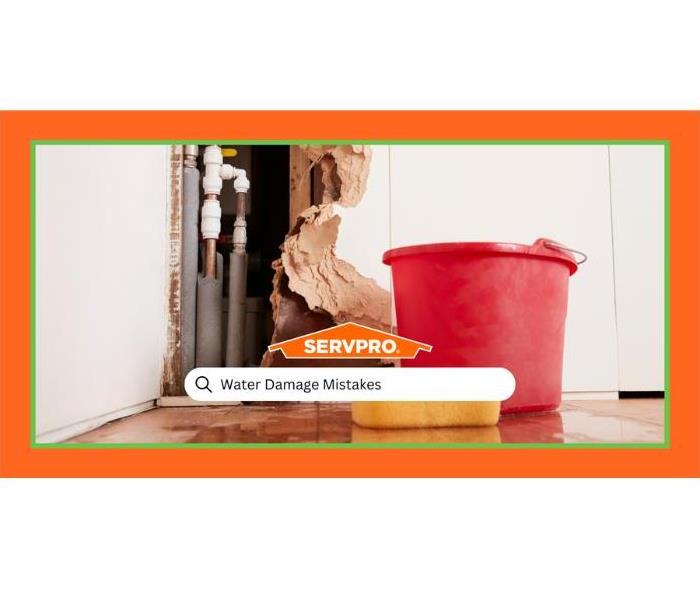 Water Damage Mistakes
Water Damage Mistakes
Water damage in your home can be overwhelming, and in the rush to salvage your belongings, you might unknowingly take actions that could put your safety at risk or make an even worse situation. When water infiltrates your home, whether from a burst pipe, flooding, or severe weather, it creates more than just visible damage. Understanding the right steps to take when facing water damage in your property is just as important as knowing when to call professional Weymouth MA water damage restoration services.
Is it safe to stay in a house with water damage?
Water can compromise your home's structural stability, create electrical hazards, and cause mold growth within 24-48 hours, making it dangerous. Making the wrong moves during critical moments could lead to a hazardous and costly disaster. Here’s our guide on dos and don’ts for post-water emergency actions:
Don't Use Electrical Appliances
Your first instinct might be to grab a vacuum or fan, but using electrical devices in water-damaged areas can be extremely dangerous. Water conducts electricity, and even slightly damp conditions can create serious shock hazards. Wait for professional assessment before using any electrical equipment in affected areas.
Don't Ignore Small Water Issues
What might seem like minor water damage today can turn into major problems tomorrow. Small leaks or damp spots can point to larger hidden issues within walls or under floors. These problems are often overlooked and can lead to structural damage and expensive repairs down the road.
Don't Wait to Take Care of the Problem
Time is of the essence when dealing with water damage. Every hour you wait allows water to seep deeper into building materials, increasing the risk of mold growth and structural damage. Quick action is of utmost importance for minimizing damage and reducing restoration costs.
Don't Try to Handle Contaminated Water on Your own
Not all water damage is created equal. Flooding and sewage backups can contain dangerous contaminants that pose serious health risks. Without the right protective equipment and training, trying to clean contaminated water can expose you and your family to harmful bacteria and pathogens.
Professional Solutions from SERVPRO of Weymouth, Hingham and Quincy Is Different
SERVPRO of Weymouth, Hingham and Quincy specializes in professional water damage restoration services throughout the greater Boston area. Our team uses advanced water detection equipment and professional-grade drying techniques to remove water thoroughly and prevent secondary damage. We understand the unique challenges of water damage in homes and businesses, and we're equipped to handle everything from minor leaks to major flooding events. Our certified technicians are at your disposal 24/7 to respond to water emergencies in the following areas:
- Boston, MA
- Weymouth
- Hingham
- Weymouth Landing
- Surrounding communities
Why We Are Different
When water damage strikes, you need a trusted partner to step in and take care of the devastating aftermath quickly. Our comprehensive water damage restoration services are designed to minimize damage, speed up the recovery, and make the process as stress-free as possible. Here’s what sets us apart:
- 24/7 Emergency Response: Our team is available around the clock to respond to water damage emergencies and minimize further damage.
- Certified Water Damage Restoration Technicians: Our professionals are IICRC certified, ensuring adequate and reliable restoration services for your property.
- Advanced Drying Equipment and Techniques: We use advanced tools and methods to thoroughly dry and restore affected areas quickly.
- Complete Documentation for Insurance Claims: We keep detailed records of damage and repairs to help with your insurance claims.
- Local Expertise with Considerable Experience: We provide personalized local service backed by years of experience in the industry.
- Comprehensive Moisture Detection and Removal: Our precise detection and removal processes are designed to remove hidden moisture and prevent mold and structural problems.
Don’t Wait: Contact Us for Expert Water Damage Restoration
Don't let water damage compromise your property's safety and value. When water damage strikes, remember that professional help is just a phone call away. Contact SERVPRO of Weymouth, Hingham and Quincy by filling out the online form for professional help. Trust our experts to handle your water damage restoration needs safely and carefully.
Burst Pipes: A Leading Cause of Sudden Water Damage in Massachusetts Homes
1/7/2025 (Permalink)
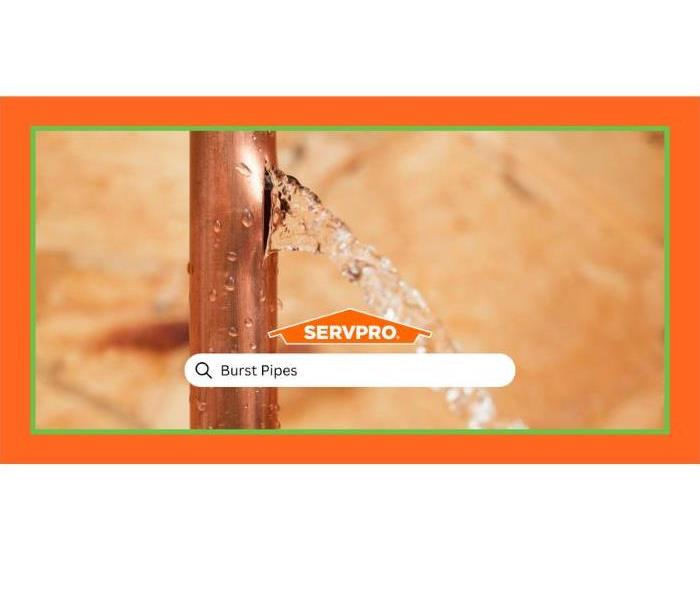 Burst Pipe
Burst Pipe
When it comes to sudden water damage Weymouth, MA homeowners can face, few scenarios are as devastating as burst pipes. These plumbing emergencies can create an absolute mess within hours, causing extensive damage to walls, floors, furniture, and personal belongings. Understanding the causes, knowing how to respond, and taking preventive measures can help protect your home from this destructive force.
Why Do Pipes Burst? Understanding the Root Causes
Several factors can be responsible for pipe failure, with three primary reasons leading the way:
Freezing Temperatures
New England winters pose a significant threat to your plumbing system. Pipes naturally expand when the water inside freezes, creating intense pressure that can crack or split the pipe. This is particularly common in unheated spaces like basements, crawl spaces, and exterior walls.
High Water Pressure
Excessive water pressure consistently strains your pipes, weakening them over time. While most residential plumbing systems are designed to handle pressure between 40-85 psi, anything above this range can damage pipes and their connections.
Corrosion and Age
Like all home components, pipes cannot last forever. Older metal pipes can corrode from the inside out, especially in areas with hard water. This corrosion weakens pipe walls, making them more prone to bursting under normal operating conditions.
Emergency Response: Critical Steps When Pipes Burst
How quickly should you respond to a burst pipe? Immediately. Time is of the essence when dealing with burst pipes. A delay of even a few hours can result in extensive water damage, mold growth, and costly repairs.
Follow these steps to minimize the damage to your property:
- Shut off your home's main water supply immediately - every household member should know its location
- Turn on faucets to drain the remaining water from the pipes
- Document the damage with photos as evidence for insurance claims
- Remove valuable items from the affected areas
- Begin water removal with mops, towels, and wet vacuums if safe to do so
- Contact a professional for expert water damage restoration
For more detailed guidance on what to do immediately after a pipe freezes and bursts, check out our tips for handling a frozen pipe burst to ensure you are prepared for this type of emergency.
Preventing Burst Pipes: Long-Term Protection Strategies
Preventing water damage in your home is always more cost-effective than emergency repairs.
Take these protective measures:
- Insulate pipes in colder areas using foam pipe sleeves or heat tape
- Maintain consistent indoor temperatures, even when you’re away
- Allow faucets to drip during extreme cold spells
- Schedule regular plumbing inspections to spot potential issues early
- Consider installing a water pressure regulator if your home's pressure exceeds 85 psi
- Upgrade aging plumbing systems before they fail
Why Choose SERVPRO of Weymouth, Hingham and Quincy
When water damage catches you off guard, you need a restoration partner you can trust. Our team stands out for several reasons:
24/7 Emergency Response
Water damage doesn't wait for business hours, and neither do we. Our emergency teams are ready to respond at any time, day or night.
Advanced Equipment
We use industrial-grade water extraction and drying equipment, as well as moisture detection tools, to ensure thorough water removal and the prevention of secondary damage.
Certified Technicians
Our restoration professionals are highly trained and IICRC certified, ensuring the highest standard of service for your property.
Comprehensive Service
From initial water extraction to final repairs, we handle every aspect of the restoration process, making it easier and more efficient for you.
Don't Wait: Contact Us Immediately for Professional Restoration
If you've got water damage from burst pipes, it's important to get help right away! At SERVPRO of Weymouth, Hingham, and Quincy, we’re ready to step in with emergency water removal services at any time. Our experienced team is on call 24/7, ready to help with all your water damage restoration needs. We're dedicated to protecting your home and restoring its safety and comfort.
Contact us for immediate help with water damage restoration in Weymouth, MA, and surrounding areas, or fill out this online form for a free estimate. Let’s start your recovery together!
Understanding and Preventing Plumbing-Related Water Damage: A Homeowner's Guide
12/10/2024 (Permalink)
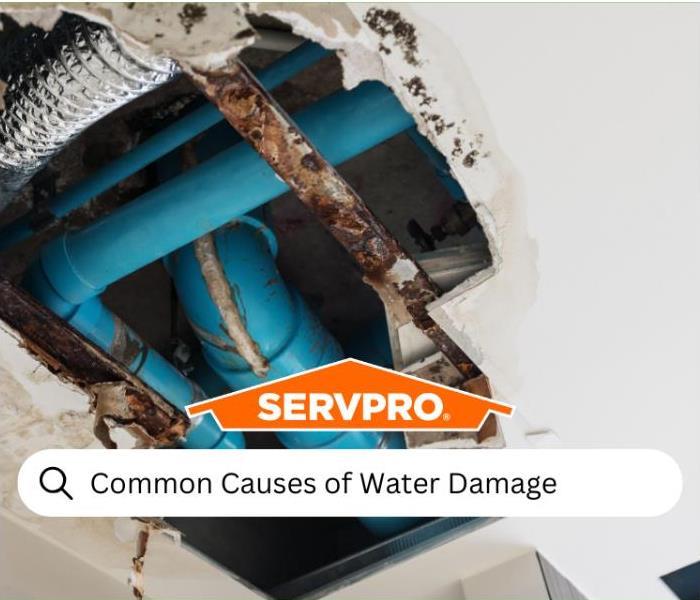 water damage from a roof leak
water damage from a roof leak
Water damage in Weymouth from faulty plumbing can strike when least expected, leading to costly repairs and potential health hazards. As one of the most common causes of property damage, plumbing issues require immediate attention and professional expertise. Understanding these problems can help homeowners prevent serious water damage and protect their investment.
What are common plumbing issues that lead to water damage?
Leaking and burst pipes often top the list of plumbing disasters. These issues often happen due to age, corrosion, or excessive water pressure. When pipes leak or burst, they can release hundreds of gallons of water within hours, causing extensive damage to walls, floors, and personal belongings.
Damaged pipes present another significant risk, particularly in older homes. Corrosion, shifting foundations, or improper installation can compromise pipe integrity, leading to slow leaks that may go unnoticed for months. Frozen pipes also pose a severe threat during cold New England winters, as expanding ice can create cracks and ruptures.
Kitchen and bathroom fixtures are also common sources of water damage. Kitchen sink leaks often develop around the faucet base or under-sink connections, while toilet overflows can result from clogs or faulty components. Bathroom sink leaks and bathtub or shower leaks usually happen due to deteriorating seals or cracked fixtures, potentially causing extensive damage to surrounding areas.
Warning Signs of Plumbing Problems
Early detection is key in preventing major water damage. It’s important to act quickly as soon as you catch any of these warning signs:
- Unexplained drops in water pressure
- Unusual sounds in pipes, such as banging or whistling
- Musty odors in bathrooms or basements
- Unexplained increases in water bills
- Water stains on walls or ceilings
- Warped or discolored flooring
- Persistent dampness around fixtures
- Mold growth in unexpected areas
Essential Prevention and Maintenance Tips
Regular maintenance can significantly reduce the risk of water damage. Here are some steps you can take to avoid water-related disasters in your home:
Conduct monthly visual inspections of exposed pipes and fixtures. Check under sinks, around toilets, and in basement areas for signs of moisture or corrosion. Install water leak detection devices near high-risk areas to provide early warnings of potential problems.
During winter months, maintain adequate heating throughout your home, especially in areas with exposed pipes. Consider adding insulation to pipes in unheated spaces and keeping cabinet doors open during extremely cold weather to allow warm air circulation.
Schedule professional plumbing inspections annually to identify potential issues before they become major problems. A qualified plumber can spot early warning signs and recommend necessary repairs or upgrades to your plumbing system.
How SERVPRO of Weymouth, Hingham and Quincy Can Help
Our certified restoration specialists are ready to respond when plumbing issues lead to water damage. Serving Boston MA, Weymouth, Hingham, Weymouth Landing, and surrounding communities, our team brings extensive experience and advanced equipment to every water damage situation.
Our comprehensive water damage restoration services include:
- 24/7 emergency response
- Professional water extraction and drying
- Advanced moisture detection and monitoring
- Mold prevention and remediation
- Complete restoration services
- Documentation for insurance claims
Act Now to Prevent Plumbing-Related Water Damage: Call Us for Expert Restoration!
Don't wait until water damage destroys your home or business. Contact SERVPRO of Weymouth, Hingham and Quincy today at for professional water damage restoration services. Our certified technicians are standing by to provide immediate assistance and help prevent further damage to your property.
10 Steps for Successful Water Damage Prevention and Cost Savings
11/12/2024 (Permalink)
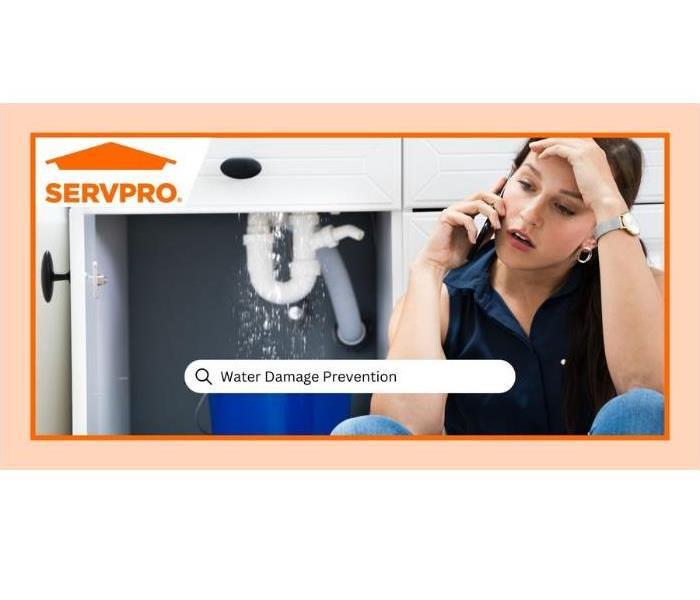 Water Damage Prevention
Water Damage Prevention
Water damage can strike any home, often leading to unexpected expenses, extensive repairs, and even health risks if mold begins to grow. Water damage prevention isn’t just about saving money - it’s about maintaining a safe, comfortable, and secure home environment. Below, we’ll cover ten essential strategies that can help you prevent water damage in Weymouth and protect your property from costly repairs.
Clear Your Gutters to Protect Your Roof and Foundation
Keeping gutters clear is an essential but often overlooked step in preventing water damage. When gutters are clogged, they overflow, potentially damaging the roof, walls, and even the foundation of your home. To avoid this, clean your gutters at least twice a year - especially in the fall when leaves can easily clog them. Consider installing gutter guards to reduce the need for frequent cleaning..
Install Leak Detectors for Early Warning
Leak detectors are an affordable, practical way to catch water leaks before they become a major problem. These small devices can alert you to the presence of water, giving you a chance to tackle the leak quickly. Install leak detectors in areas prone to water leaks, like the basement, near the water heater, and under sinks. For added peace of mind, some detectors can connect to your smartphone.
Regular Roof Inspections to Prevent Water Leaks
Small issues with your roof, like damaged shingles or loose flashing, can lead to larger leaks if left unattended. Regular inspections help you catch these problems early. Schedule annual roof inspections, especially after a heavy storm. Replace damaged or missing shingles immediately to ensure your roof remains watertight. This small maintenance task can save you from more extensive repairs down the line.
Fix Leaks Immediately to Prevent Further Damage
It’s easy to ignore a slow-dripping faucet or minor pipe leak, but delaying repairs can lead to much more significant issues, including structural damage and mold growth. Do regular plumbing inspections, looking for signs of leaks around sinks, toilets, and under cabinets. If you find any leaks, fix them immediately. Early action here can make a big difference. You may wonder: ‘Why is it important to fix even minor leaks right away?’ Ignoring minor leaks can lead to bigger issues, such as weakened structures or mold infestations.
Maintain Your Appliances to Avoid Water Leaks
Appliances like washing machines, dishwashers, and refrigerators can lead to hidden water damage if not maintained properly. Here’s how to keep them in top shape and avoid leaks:
- Inspect Hoses and Connections Regularly: Every few months, check hoses and connections for signs of leaks or wear.
- Replace Worn-Out Parts: If you find any old or damaged parts, replace them to prevent leaks.
- Schedule Routine Maintenance: Set up regular maintenance for major appliances to ensure they remain in peak condition.
Monitor and Control Water Pressure
Maintaining the right water pressure in your home is crucial for preventing leaks and protecting your plumbing system. High water pressure can put excessive stress on pipes, leading to costly damage over time. Here’s how to keep your water pressure in check:
Install a Water Pressure Regulator
A water pressure regulator can help maintain safe pressure levels in your plumbing system, typically between 40–60 PSI. This device ensures that your pipes are not subjected to excessive force.
Regularly Check Your Water Pressure
Make it a habit to check your water pressure periodically. This simple step can help you catch any fluctuations early, allowing you to take action before stress on your plumbing system leads to damage.
Inspect and Replace Old Pipes
Older pipes, especially those made from materials like galvanized steel or iron, are more prone to corrosion and leaks. Regularly inspecting and replacing old pipes is crucial to avoid potential bursts. If your home has older plumbing, schedule regular inspections with a plumber to assess the condition of your pipes. Replacing outdated pipes can prevent costly water damage down the line.
Install a Sump Pump and Test It Regularly
For homes with basements or those in flood-prone areas, a sump pump is essential in preventing basement flooding during heavy rain. If you don’t already have a sump pump, consider installing one as a preventative measure. Test it periodically to make sure it’s working properly, especially before the rainy season.
Shut Off Water Supply When You’re Away
Water leaks can be disastrous if they happen while you’re away from home. Shutting off the main water supply can prevent this when you’re going on an extended trip. Whenever you plan to be away for more than a few days, shut off the water supply to your home. For added protection, consider installing automatic shut-off valves that can cut off the water supply if they detect a leak, even when you’re not there.
Do Regular Home Inspections to Catch Problems Early
A thorough home inspection every few months can help you identify early signs of potential water damage. Key areas to focus on include the roof, plumbing, basement, and appliance connections. Create a checklist for home inspections to ensure you don’t miss anything. For professional assistance, consider hiring a home inspector annually.
Protect Your Home with Proactive Water Damage Prevention
Water damage prevention is all about regular maintenance, vigilance, and taking quick action when issues arise. By following these steps, you can save thousands on repair costs and keep your home safe from water-related issues.
Get Professional Help for Water Damage Prevention and Restoration
If you’re facing water damage or need expert help, contact SERVPRO of Weymouth, Hingham, and Quincy at (781) 337-0344. Their professional water damage restoration services can help restore your home and prevent further issues. Don’t wait for water damage to become a problem - take preventive action today!
Water Damage Inspection: How to Check Your Home After Heavy Rain
10/15/2024 (Permalink)
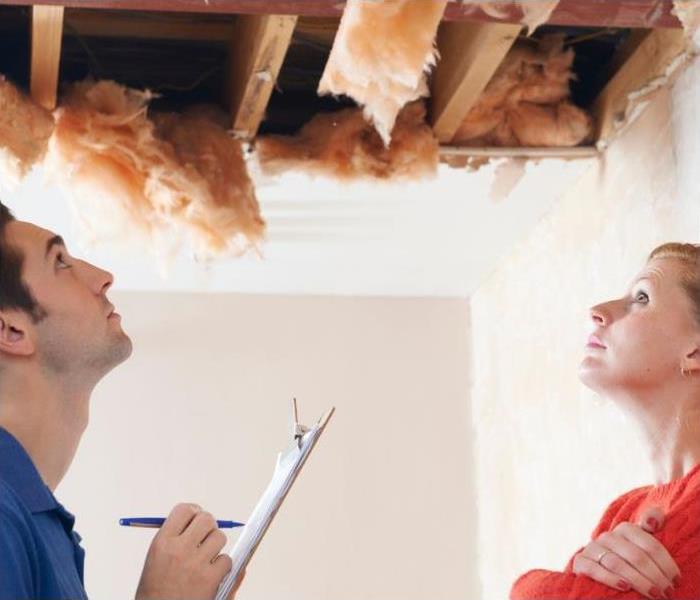 Water damage inspection team
Water damage inspection team
After heavy rainfall, doing a thorough water damage inspection is essential to protecting your home from long-term problems. If left untreated, water damage can lead to mold growth, structural issues, and costly repairs. Inspecting key areas of your home after rain will help you catch and tackle any issues early. If you're already seeing signs of water damage, check out water damage restoration Weymouth services or contact your local expert for professional help. Here's what to look for and how to prevent further damage.
Areas to Inspect for Water Damage
During your home inspection after rain, focus on these areas that are most vulnerable to water damage after heavy rain:
Roof
Start by carefully inspecting your roof for roof leaks. Look for damaged or missing shingles, as these can allow rainwater to seep through. Don't forget to check the attic for any signs of water seepage, such as damp insulation or dark spots on the wood. These signs may reveal underlying issues that need immediate attention.
Gutters and Downspouts
It is important to maintain a gutter properly to avoid water pooling near your home’s foundation. Clear out any debris, such as leaves and twigs, to ensure that gutters can channel water effectively. Make sure downspouts are directing water away from the house, ideally at least 3 to 6 feet away from the foundation. This helps prevent water from accumulating near your home and causing damage.
Foundation
Heavy rains can create foundation cracks or lead to water pooling around the base of your home. Inspect the foundation for any visible cracks or signs of water intrusion. If you notice water pooling, it can compromise the stability of your home and lead to serious structural issues if not tackled promptly.
Exterior Walls
Examine your exterior walls for any cracks or gaps where water may have entered. Look for damp patches or water stains around windows and doors, as these are key signs of rainwater intrusion. Even small openings can allow moisture to penetrate, leading to bigger problems like mold growth and rot.
Windows and Doors
Inspect the seals around your windows and doors for signs of wear or deterioration. Check for gaps or cracks in the caulking or weather stripping. Faulty window and door seals can allow water to leak into your home, resulting in potential water damage and increased energy costs.
Interior Walls and Ceilings
Once inside your home, check for stained walls and ceilings that may indicate leaks coming from the roof or exterior walls. Pay special attention to corners and areas near plumbing fixtures. Water stains can be a clear indicator of existing water damage and may require immediate repair to prevent further issues.
Floors
Finally, examine your floors for any signs of warping or dampness, particularly in areas like the basement, where basement flooding is common after heavy rain. Look for damp spots or discoloration that may indicate water pooling underneath the flooring. Taking the time to inspect these areas can help you identify and handle water damage before it escalates.
Tools to Use During Inspection
Certain tools can help you detect hidden water damage during your inspection:
- Moisture meter: Detects dampness behind walls and under floors.
- Infrared camera: Helps spot leaks by showing temperature differences caused by moisture.
- Flashlight: Useful for inspecting dark areas, like attics or crawl spaces.
Common Signs of Water Damage
During your water damage inspection, look out for these common signs:
- Mold and Mildew: These grow in damp areas and are clear indicators of a moisture problem. Check for visible mold growth in corners, on walls, and around windows. If you notice black, green, or white spots, tackle the moisture source immediately, as mold can lead to health issues and structural damage if left untreated.
- Musty Smell: A lingering musty smell often points to hidden water damage. This smell typically comes from damp or decaying materials. If you notice a musty smell in your home, investigate potential sources, such as water-stained areas, hidden leaks, or damp basements. Ignoring this smell may lead to more significant issues, including mold growth.
- Water Stains: Look for water stains on walls, ceilings, or floors. Discoloration, such as yellow, brown, or gray spots, is a major red flag for rainwater damage. These stains often indicate past or present leaks from roofs, plumbing, or exterior walls. Investigate the source of these stains to prevent further damage and ensure a safe living environment.
What to Do if You Find Water Damage
If you find water damage, take these steps immediately:
- Dry out the area: Use fans and dehumidifiers to dry wet areas quickly to avoid further damage and mold growth.
- Call a professional: For proper restoration, contact experts in water damage restoration to inspect and repair the damage.
Prevention Tips for Future Water Damage
Learn more about how to prevent water damage in your home. To prevent water damage after future rainstorms, follow these maintenance tips:
- Clean your gutters regularly: Gutter maintenance is very important. Make sure they can handle heavy rainfall.
- Inspect your roof: Do this annually for damaged shingles.
- Maintain Your Drainage System: Pay special attention to the area around your home’s foundation to keep water from pooling.
- Check window and door seals: Do this regularly for any wear and tear.
Protect Your Home: Get a Professional Water Damage Inspection
If you've noticed any signs of water damage after a heavy rain, don't delay. SERVPRO of Weymouth, Hingham, and Quincy offers expert water damage inspection and restoration services. Our team is ready 24/7 to help restore your home. Call us today at (781) 337-0344 or complete an online form to schedule your inspection and protect your home from further damage. SERVPRO® water damage services are here to help you keep your home safe and dry!
Water Damage from a Roof Leak: Prevention and Restoration Tips
10/9/2024 (Permalink)
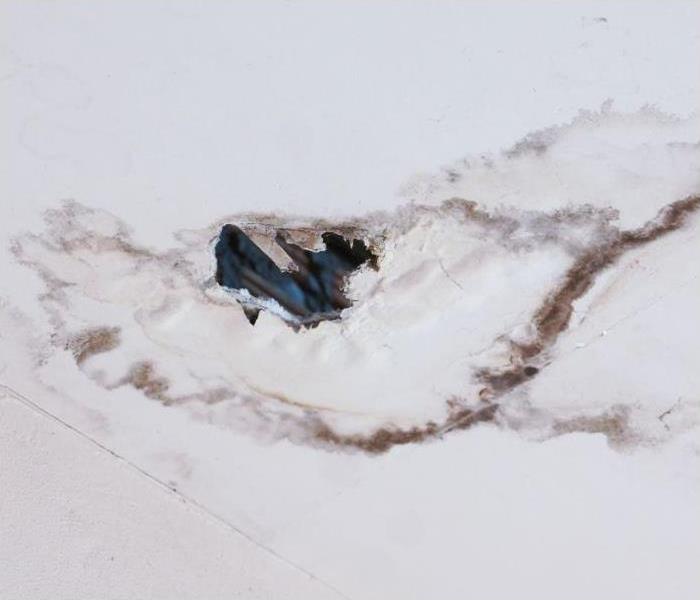 Water damage from a roof leak
Water damage from a roof leak
Water damage from a roof leak is a common yet serious problem for homeowners. While a small leak might seem like a minor issue, it can lead to significant water damage if not tackled quickly. Water infiltration through the roof can compromise the structural integrity of your home, lead to mold growth, and result in costly repairs. This makes it essential for homeowners to act quickly when a leak is discovered. Timely intervention is crucial, and professional services like those Weymouth water damage restoration experts offer can help prevent further damage and restore your home to its original condition.
Common Causes of Roof Leaks
Roof leaks can result from various factors, each leading to potential water damage if not managed properly. Some of the most common causes include:
- Damaged Shingles: Shingles can become cracked, curled, or missing due to weather conditions or aging, allowing water to penetrate the roof.
- Clogged Gutters: When gutters are blocked by leaves, dirt, or debris, water can overflow and seep into the roof, causing leaks.
- Improper Installation: Poorly installed roofs are more susceptible to leaks, especially during heavy rainfall or snowmelt.
Early Signs of Water Damage from a Roof Leak
Recognizing the early signs of water damage is crucial to preventing extensive harm to your home. Roof leaks often start small, making it easy to overlook the initial warning signs. Here are some of the most common early indicators of water damage caused by roof leaks:
Stains on Ceilings
One of the most noticeable signs of a roof leak is the appearance of yellow or brown stains on your ceiling. These stains are typically the result of water seeping through the roof and saturating the ceiling materials. Over time, the stains can grow larger as more water enters the home, eventually leading to sagging ceilings and structural damage.
Peeling Paint
When water infiltrates the walls of your home, it can cause the paint to bubble, blister, or peel. This is often a sign that moisture is building up behind the walls, which can lead to mold growth and further deterioration of the affected area. If you notice peeling paint, especially in areas near the ceiling or roofline, it’s important to investigate the cause and handle any leaks as soon as possible.
Mold Growth
Mold grows in damp, dark environments, making your attic or the area around a roof leak an ideal breeding ground. The presence of mold, particularly in the attic or on ceilings, is a clear sign of ongoing water leakage. Mold can pose serious health risks, especially for individuals with allergies or respiratory conditions, so it’s essential to tackle mold issues as soon as they are detected.
Warped or Buckled Walls and Floors
Water damage can cause walls and floors to warp, buckle, or become soft to the touch. This is a sign of significant water infiltration and structural damage, and it requires immediate attention to prevent further deterioration.
Preventative Measures to Avoid Water Damage
Preventing roof leaks and the resulting water damage involves a combination of routine maintenance and proactive measures:
- Regular Maintenance: Inspect your roof regularly for damaged or missing shingles and have them repaired quickly.
- Clear Gutters: Keep gutters free from debris to ensure proper water flow away from your roof.
- Repair Damaged Shingles: Handling shingle damage quickly can prevent leaks from developing.
Steps to Take When You Discover Water Damage
If you notice signs of water damage, it’s essential to act quickly to minimize the impact. Here’s what you should do:
- Contain the Leak: Place buckets or containers to catch dripping water and prevent further damage.
- Dry Affected Areas: Use fans and dehumidifiers to dry out wet areas, reducing the risk of mold growth.
- Document the Damage: Take photos and make a list of all the areas and items affected by the water damage. This documentation will be helpful when filing an insurance claim
- Contact Professionals: Reach out to a water damage restoration company immediately. Quick action can prevent the situation from worsening and reduce repair costs.
The Restoration Process
Water damage restoration is a multi-step process that ensures your home is thoroughly dried and repaired. The typical process includes:
- Water Extraction: The first step in the restoration process is to remove any standing water from your home. Professionals will use specialized equipment to extract water from carpets, floors, and other surfaces, helping to prevent further damage and reduce drying time.
- Drying: After the water is removed, high-powered fans and dehumidifiers are used to dry out affected areas. This step is critical to ensuring that no moisture remains, as even small amounts of water can lead to mold growth and further damage.
- Cleaning and Sanitizing: Once the area is dry, professionals will clean and sanitize the affected areas to remove any contaminants and prevent mold growth.
- Repair: The final step in the restoration process is to repair or replace damaged materials. This may include replacing drywall, insulation, flooring, and other materials that were affected by the water.
Don’t Let Water Damage Take Over - Act Now with SERVPRO of Weymouth, Hingham, and Quincy!
If you’ve spotted signs of water damage in your home, don’t wait until it’s too late. Protect your property and peace of mind by calling the experts at SERVPRO of Weymouth, Hingham, and Quincy. With our fast and reliable water damage restoration services, we’ll help you get your home back to its best condition in no time. Call us at (781) 337-0344 or complete an online form on our website.
The Impact of Hard Water on Your Plumbing and How It Can Lead to Water Damage
10/1/2024 (Permalink)
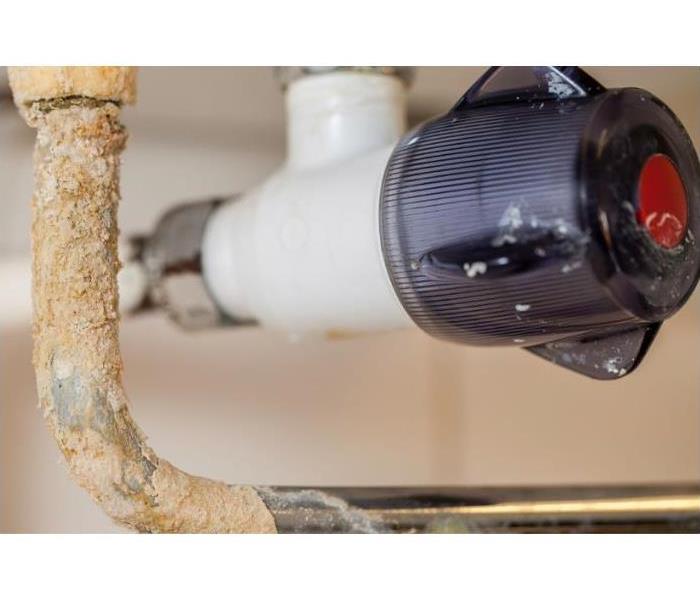 Hard Water on Your Plumbing
Hard Water on Your Plumbing
Hard water is a common issue faced by many homes and businesses. It contains high levels of minerals, such as calcium and magnesium, which can cause significant problems for plumbing systems. Over time, these minerals accumulate in pipes and appliances, leading to a range of plumbing issues that, if left unchecked, can result in water damage. If you're experiencing plumbing problems caused by hard water, a Weymouth water damage restoration company or your local experts can help prevent these issues from escalating into costly repairs.
What is Hard Water and How Does It Affect Plumbing?
Hard water refers to water that contains high concentrations of dissolved minerals, primarily calcium and magnesium. While hard water itself is not harmful to health, it can have damaging effects on your home’s plumbing system. As the water flows through pipes, mineral deposits are left behind, gradually forming scale buildup that restricts water flow and leads to increased pressure. Over time, this can result in burst pipes leaks and cracks which can cause significant water damage. Read on to learn more about the effects of hard water on plumbing systems and take steps to protect your home or business from water damage.
How Hard Water Leads to Plumbing Issues
Hard water can have serious consequences for your plumbing system, causing a range of issues that can lead to costly repairs and water damage if not tackled early. From mineral deposits that restrict water flow to the faster wear and tear of appliances, understanding how hard water affects your plumbing is important for preventing long-term damage.
Scale Buildup
Mineral deposits from hard water accumulate on the interior surfaces of pipes and appliances, forming what is known as scale buildup. This buildup causes water flow restriction, leading to blockages and increasing pressure within the pipes. As pressure builds, pipes may crack or burst, leading to leaks and potential water damage. If you notice restricted water flow or increased water pressure, these may be early signs of plumbing issues caused by hard water.
Corrosion and Pipe Damage
Hard water also interacts with metal pipes, causing corrosion. Over time, corrosion weakens the pipes, leading to the formation of holes or cracks. As the damage worsens, water can escape through these cracks, leading to leaks or pipe bursts. Pipe corrosion caused by hard water can lead to hidden leaks behind walls or under floors, which can cause significant structural damage if left unaddressed.
Decreased Efficiency of Appliances
Appliances that use water, such as water heaters, washing machines, and dishwashers, are particularly susceptible to the effects of hard water. Scale buildup inside these appliances reduces their efficiency and shortens their lifespan. Appliances may require more energy to function properly, leading to higher utility bills and more frequent repairs. The reduced efficiency of appliances caused by hard water can also increase the risk of water damage prevention being overlooked.
Signs of Hard Water Damage in Your Home
Identifying the signs of hard water damage early can help you prevent costly repairs and water damage. If you notice any of these signs, it’s essential to take action before small plumbing issues turn into significant water damage problems:
- Pressure: Reduced water pressure due to scale buildup in pipes.
- Rust: Visible rust stains or discoloration around faucets and drains.
- Discoloration: Discolored water, which may indicate corrosion in pipes.
- Bills: Increased utility bills from decreased appliance efficiency.
- Repairs: Frequent need for plumbing repairs due to leaks or pipe damage.
Prevention and Solutions
Preventing the damaging effects of hard water on your plumbing system requires proactive measures. Fortunately, some solutions can help protect your pipes and appliances from scale buildup and corrosion.
- Water Softeners and Filtration Systems: Installing a water softener or water filtration system can help mitigate the effects of hard water by reducing the concentration of minerals in your water supply. A water softener removes calcium and magnesium, preventing scale buildup and corrosion in your pipes and appliances. This can significantly reduce the risk of hard water, leaks in your home water system. and you will be able to avoid pipe replacement.
- Regular Inspections and Maintenance: Doing regular inspections of your plumbing system is necessary for identifying early signs of damage caused by hard water. Handling scale buildup, corrosion, or small leaks early can prevent more extensive damage and costly repairs down the road. By scheduling routine maintenance, you can avoid major issues like burst pipes and water damage in your home or business.
Potential Water Damage from Hard Water
Hard water can cause hidden leaks or pipe bursts that, if unnoticed, can lead to significant water damage. Over time, leaking water can seep into walls, floors, and ceilings, causing mold growth, structural damage, and expensive repairs. Water damage from hard water can also lead to flooding risk especially if pipes burst due to increased pressure or corrosion. You can prevent long-term damage and costly renovations by tackling these plumbing issues quickly.
How SERVPRO of Weymouth, Hingham, and Quincy Can Help
When plumbing issues caused by hard water lead to water damage, professional restoration services are essential to mitigate the damage and restore your property. SERVPRO® water damage services include a thorough inspection of plumbing systems, water damage mitigation, and structural repairs. The team at SERVPRO of Weymouth, Hingham, and Quincy is equipped to handle all aspects of water damage restoration, from identifying hidden leaks to repairing damaged pipes and preventing future issues. Call us at (781) 337-0344 or fill out an online form on our website.






 24/7 Emergency Service
24/7 Emergency Service









